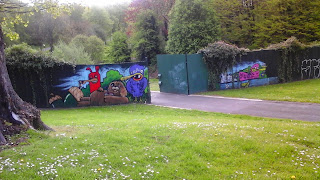Blog Day 6
The Corrymeela
Community
After our busy and
inspiring day on Thursday, we wondered if our brains could possibly hold any
more information. But amazingly, our capacity to keep expanding our
perspectives and abilities to hold new ideas was large.
Friday morning we
met with Colin Craig, Executive Director of Corrymeela. A former Centre
Director during the 1990s, Colin spoke about the massive change that the organization
has undergone in the past year. From changes to volunteer and staff structures,
reducing the environmental footprint, to changes in funding and communications,
he talked about how the organization is trying to live out the mission of “living
and learning well together.”
Since leaving
Corrymeela as its Centre Director in 2001, Colin developed several
organizations, including TIDES Training, working with communities in Northern
Ireland and other countries around the world including Bosnia, Kosovo, and
Pakistan. He then helped develop a city wide collaborative called Youth
Intervention Network in California, and Different Tracks Global (DTG). He
brings this wisdom and experience to the new position, and it is clear from
talking to staff and volunteers that there is excitement and enthusiasm as
folks move forward.
One of the biggest
changes has been the creation of the two distinct leadership positions within
the organization, with the clear division of role and responsibility.
Previously, many of the administrative and organizational roles would have been
lodged in the Centre’s Leader as well as being the spiritual head of the community.
Last fall, Padraig O Tuoma was named Leader of the Community. This is an excerpt from a press release on the website:
“Padraig brings a wealth of experience
from his work in poetry, theology and conflict transformation around the world …
Pádraig will work closely with Executive Director Colin Craig and the staff
team to run programmes of respite, encounter, dialogue and reflective learning
for the 11,000 visitors that come through the Ballycastle Centre each year. He
will represent Corrymeela in current public debates and build relationships
with church and faith communities in Northern Ireland and beyond.”
I had mentioned
that Thursday the leader of the community, Padraig O Tuama, had welcomed us
into his home for coffee and conversation. It was an amazing gift to sit with
Padraig for an hour, hearing him speak about his own experiences of encounters
of “faith in the public square.” As a lover of language and a poet, Padraig
speaks powerfully and eloquently. He knows his own tradition well, and speaks
of having the space in one’s own tradition to “question the corners”. He asks
provocative questions ... “How can a community hold its story well?”, “what is its relationship with difference?”, “How
do we safeguard the virtue and value and wonder of curiosity?” and “What is the
ethic of engagement when you disagree?” It was a holy space with Padraig, one
that I will remember for a long time.
Friday evening was
spent with Marianne and Ruth, long time community members who were on site for
the weekend to do “cover” (kind of like a duty manager, keeper of the keys, the
buck stops here kind of role …) They each told their stories – how they came to
be community members and their first encounter with Corrymeela, why it is still
important to them, its challenges, and several stories. It was a great
opportunity to find out how the community works at the grassroots level.
And of course, all
week long we have had the delight of being with two of the long term
volunteers, Beni from Switzerland and Diego from El Salvador, and have also met
many others over mealtime conversations.
Many perspectives,
all interwoven to form what is the Corrymeela Community. It never ceases to
delight and amaze me.





































